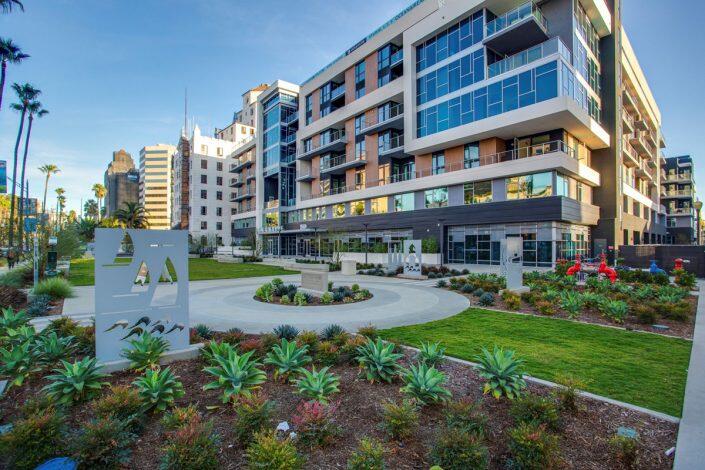UPDATED, April 12, 2022, 1:12 p.m.: Public housing has gone middle class.
Billed as “workforce housing,” it mimics a private-sector trend in places where home prices and rents have soared beyond the household budgets of many working professionals, who find themselves locked out of homeownership and hard-pressed to afford monthly rents. Making the market work requires a little government help.
“Cities are looking at a broader use of subsidy further up the income scale because there is a shortage of moderately priced housing for critical members of the workforce,” said Christopher Ptomey, who heads the Terwilliger Center for Housing at the Urban Land Institute.
Both Los Angeles and Miami housing are “vastly under-supplied at moderate-income levels,” Ptomey said.
“Those markets are worst-case examples,” he said.
That helps explain why subsidies for workforce housing have been coming at a rapid clip lately in Southern California and South Florida. They tend to generate official announcements that lend a veneer of market-driven sensibilities to deals that are often touted as public-private partnerships on the West Coast.
Not quite.
In Southern California, a public entity called the California Statewide Communities Development Authority (CSCDA) issues bonds — typically tax-free instruments — to finance deals that involve private developers.
Except there is no development — the deals involve buying existing apartment complexes by a public entity. Rents are adjusted to below-market rates for qualified residents. The private “partner” in the deal isn’t an owner— instead, companies sign on to manage the properties on a fee basis.
The public entity that issued the bonds — usually on behalf of a city — aims to take in enough rental revenue to pay management fees, maintain the properties and pay off bondholders. Once the bond debt is retired, the public entity owns the complex outright.
Et voila! Public housing for the middle class.
Read more



Housing as hedge
“We’re like an asset manager,” said John Drachman, co-founder of Newport Beach, California-based Waterford Property Company, which has charged into workforce housing with 12 deals that total $2.4 billion for workforce projects in Los Angeles, Orange and San Diego counties since the beginning of 2021.
Waterford does everything from ground-up development of market-rate apartment complexes to affordable projects. The company’s workforce housing division– dubbed its “Essential Housing” unit—stands apart as a niche. The demand for subsidized middle-class rental units seems here to stay—and the public entity bears the lion’s share of the risk.
The CSCDA offers somewhat of a hedge for the private sector with stability rather than the sort of risk-reward equation that has been at the heart of the development of housing for generations in Southern California.
“To be frank, developers would make a lot more if they just purchased the properties outright,” said Jon Penkower, managing director of the CSCDA.
Waterford’s deal for the Oceanaire complex in Long Beach in March cost $120 million, with all the funding raised through the sale of tax-exempt bonds.
Rents at the 200-unit complex were slashed by nearly 40 percent for qualified tenants. Average rents for two-bedroom units dropped to $2,366 from $3,905.
With public-entity ownership, there’s less incentive to maximize returns through higher rents and operating margins, Drachman said.
That’s a recipe for long-term rent stabilization—the CSCDA plans to hold the complexes at least for the duration of the bonds issued for each property — usually 30 to 35 years. The typical outlook foresees the city where the property is located taking ownership of it once the bonds are paid off. The city then can continue to operate the property as subsidized housing — operating costs would be lowered with the bonds paid off — or could sell.
“There’s a potential windfall of equity [for the city],” Drachman said, adding that Waterford’s agreement bars it from buying the property.
Sunbelt spreads
The workforce housing trend plays out differently in South Florida, where some developers include below-market units in exchange for financing or extra density granted to new development projects.
There’s even a secondary market of sorts for the subsidized units. In some cases, luxury developers get off the hook on local requirements for workforce units through a payment in lieu. They either hand money—often millions of dollars–– over to municipal public housing programs or directly contribute to another company’s mid-market project. The risk is thus held by the private sector, but spread among developers and their investors––often pension funds that are warming up to backing middle-class rentals.
Fort Lauderdale-based Affiliated Development builds ground-up mixed-income apartment buildings that include workforce units, according to co-founder Nick Rojo.
“You are not going to make the most money in it,” Rojo said, but “you are going to have a very predictable steady stream (of rental income) from the building.”

Affiliated Development’s Bohemian project in Lake Worth Beach. (MSA Architects)
Affiliated’s 200-unit Bohemian project under construction in Lake Worth Beach – with 42 workforce units – was partly financed with $1.8 million from the city’s Community Redevelopment Agency. The city forked over the money in exchange for public infrastructure work. The developer got another $1.8 million from a Palm Beach County workforce housing exchange program.
Under the county exchange program, homebuilder GL Homes opted out of building required workforce units for a project elsewhere in the county and instead made the payment to Affiliated. That helped Affiliated’s project pencil out, Rojo said.
The project also scored a $34.1 million loan and took out $11 million from Affiliated’s $125 million mixed-income rentals fund.
Investors in the fund include the Fort Lauderdale Police and Firefighters’ Pension Fund, West Palm Beach Police Pension Fund, Hollywood Police Pension Fund, Hollywood Firefighters’ Pension Fund and Miramar Police Pension Fund––all organizations that represent the kind of professionals that workforce housing targets.
“Our investors are the ones going through this problem,” Rojo said. If there is a workforce project near their members’ jobs, “they are benefitting from it.”
The trend remains a relative blip. In California, around 7,500 units of workforce housing are owned by the CSCDA — about 0.1 percent of the state’s rental stock, according to census data.
Miami has seen 1,860 workforce units built or approved since 2014, although the trend picked up steam in the last two years, with 3,122 units proposed, city data show. It’s still well under 1 percent of Miami-Dade County’s rental stock.
Litmus tests
Whether the workforce housing trend has legs will likely be revealed in Southern California and South Florida.
The two regions take different approaches to the concept, but they share a number of key factors that have made them pioneers.
Both are warm-weather regions with coastlines that have made them touchstones of the global luxury residential real estate market. Both are anchored by big cities—L.A. and Miami—that raise the profile of their larger metro markets. Both have a transplant-heavy population. And both have accommodated robust multifamily development that has sprawled inland.
On top of all that has been Covid-19, which led to an unexpected boost in residential markets, with home prices and rents hitting new highs.
The result is a very real, community-based example of the income disparity that could continue to fuel the push into workforce housing. Renters in Miami and L.A. increasingly face a high-low split, with luxury units for high earners and subsidized units for low-income individuals and households.
It’s a lack of inventory in between that has given rise to talk of “the missing middle” that fit the budget of those working professionals who can’t afford the high end but earn too much to qualify for traditional forms of housing aid.
“True affordable housing or subsidized housing only covers a smaller subset of the population,” said Anthony De Yurre, an attorney at Bilzin Sumberg who helps structure South Florida workforce housing deals.
“The reality is there is this entire band of blue collar members of our community – teachers, police officers, firefighters, nurses – that are really in this band of rental where they are priced out buying their own home and they are priced out of renting a luxury product,” he added. “Every day, there is more demand for it from tenants and there are more developers looking.”
Not for everyone
The complexities of public financing and limited returns on workforce housing deals mean that it’s just not the right game for many developers.
Cityview in Los Angeles and Estate Companies in Miami are able to charge “workforce” rents by lowering upfront costs, often on smaller units or projects in markets luxury developers generally would shun.
“We won’t buy land in Downtown Los Angeles or Beverly Hills, since those areas are expensive already,” Cityview CEO Sean Burton said.
In January, the firm paid $22 million for a fully entitled site for a 265-unit apartment complex in Gardena, a South Bay city about 15 miles south of L.A.
Gardena has traditionally been home to a generally working-class population—with significant communities of color— thanks in part to its proximity to the local sea ports. More recently, it has landed some big employers from the new economy, including Amazon’s Ring subsidiary and SpaceX.
Cityview aims to meet the market with rents within range of local budgets—the City of Gardena pegs the local median household income at around $80,000.
One potential reason that Cityview doesn’t take any financing from government entities is because there is none for ground-up workforce housing development in California.
The CSCDA is looking to create a financing program for workforce housing construction, though nothing is set in stone yet.
“[Affordable and workforce housing] costs so much to build, it makes sense that [the CSCDA and its partners] would rather buy and convert,” Cityview’s Burton said. “But you’re still not adding to the housing stock if you do it.”
The California Housing Finance Agency does have a program to support new construction for housing designated between 40 and 120 percent of area median income — technically both affordable and workforce housing — but few units have been built. Affordable housing construction subsidies are capped at 80 percent of AMI.
At Estate Investments’ buildings in Miami, one-bedroom apartments could be as much as 200 square feet smaller and roughly $500 less in monthly rent than a unit in a nearby property, said Robert Suris, managing principal. The developer also looks for other cost-cutters such as tandem parking, allowing a drop in the overall garage size and a reprieve on upfront construction costs.
Estate also has dived into hairier deals that can be bought on the cheap, “deals that have environmental or zoning issues or have all kinds of issues that a lot of people shy away from.”
“There is opportunity in every market,” Suris said. “You just have to be out there looking for them.”
Rhetoric vs reality
The Florida Housing Finance Corporation, a state authority, provides some low-interest loans to developers who build workforce housing. They can couple them with other financing packages, such as low-income housing tax credits and a multifamily revenue mortgage bond program.
Related Urban, the affordable housing arm of Jorge Pérez’s Related Group, has used such financing at the Liberty Square project in Miami’s Liberty City. Once a strictly public housing project, Related is converting it to a mix of public, affordable and workforce housing.
It’s still an open question whether workforce housing is truly alleviating the crisis for the middle class or is a mere marketing campaign that creates lucrative property management contracts and density bonuses for developers.
The issue has touched off a firestorm in Miami’s Little Haiti, a quickly gentrifying neighborhood.
The city’s Special Area Plan provision allows owners of more than 9 contiguous acres a density bonus negotiated with the city in exchange for community benefits such as workforce housing. But the units are too small for many households in Little Haiti, where it is common for several generations to live under the same roof.
“The nuances are never considered,” said Anthony Parrish, a developer who sits on the Miami planning board that reviews projects. “You could make a case for saying that who they are really after is people in their 20s and 30s, who don’t have any kids, who don’t mind living in a high-rise and can pay up to $2,000 a month in rent to start off with. … So it’s all smoke and mirrors.”

Sabal Palm Village at Flagler Trail. (Kobi Karp)
Justin Podolsky’s Sabal Palm Village at Flagler Trail, proposed as a Special Area Plan, would replace the existing Design Place apartment complex with 5.9 million square feet of commercial real estate, including nearly 3,000 rental units spread across towers that could reach as high as 20 stories.
Podolsky designated 512 of his project units as workforce housing in response to a push by city planning board members. Design Place residents have first priority to move in at the same rents they pay now. Podolsky’s attorney, Melissa Tapanes Llahues, said that the median income in the Little Haiti where Sabal Palm would rise is $46,100, squarely within the mid-range for the area.
Figuring out median incomes in local jurisdictions and the various rules on qualifying for programs such as workforce housing is complicated. Announcements by public agencies and private developers tend to toss around the term with little explanation, and local media outlets haven’t pressed the subject much.
The lack of debate has left some strategic flaws unaddressed.
Ken Johnson, an expert on rental housing at Florida Atlantic University, said a key drawback of workforce housing as it’s been pursued is that it tends to go dormant until the market gets so hot that affordability becomes an issue.
“I think a major cause of affordability and workforce housing is failure to act with developers at the bottom of a housing cycle, not at the peak,” Johnson said. “We could have gone a long way in solving this problem in 2012 when we were at the bottom of the housing market. We didn’t hear anything about affordability at the time because the market was solving it. But only temporarily.”
Follow the money
All of Waterford Property’s 15 workforce housing projects have come about through a state joint-powers authority called the California Statewide Communities Development Authority. The CSCDA issues tax-exempt bonds to raise funds to buy market-rate apartment properties on behalf of cities, counties, the state and other governmental entities.
The bonds are tax-exempt. Private developers that work with the CSCDA, meanwhile, take on none of the debt or get any equity. They get paid for finding acquisition candidates and managing the properties once they are acquired and converted to workforce housing. For a deal on the 216-unit Oceanaire complex in Long Beach that the CSCDA acquired last year for $121 million, Waterford was paid $2 million in fees, with Goldman Sachs getting the same amount for underwriting the bonds, according to documents from the city of Long Beach. Waterford will also receive $200,000 per year as part of the deal.
Waterford also receives a $5 million subordinated bond for each deal from the CSCDA, which makes regular payments once senior debt is paid. The company will receive interest payments from the subordinated bond once there’s enough revenue to pay off senior debt — probably in five to seven years, according to Jon Penkower, the CSCDA’s managing director. It’ll receive the entire principal on the bonds once everything is paid off in 30 to 35 years. — Isabella Farr
This story has been corrected to reflect that payments under a subordinated bond are made once senior debt is paid off, not retired.

